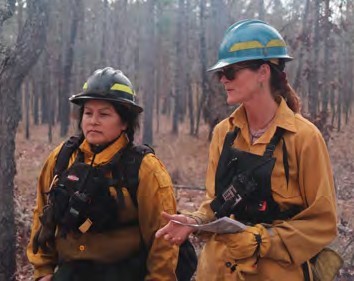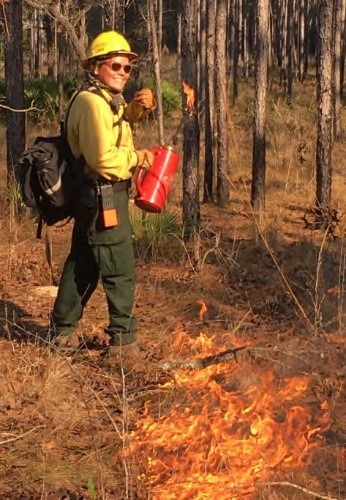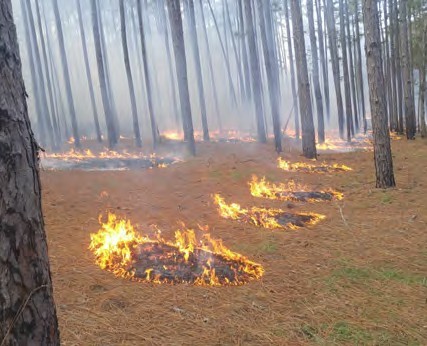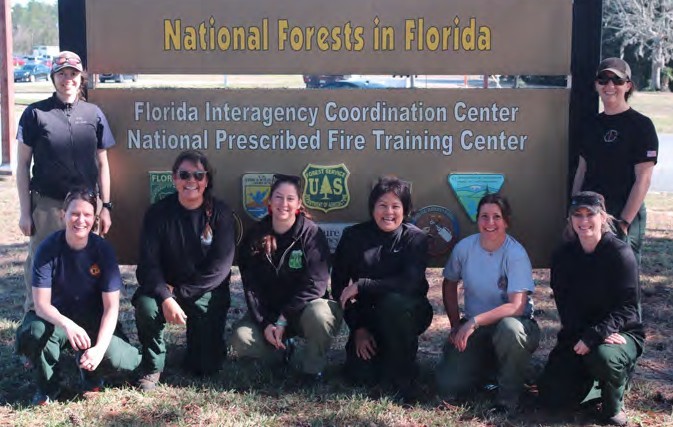You are viewing ARCHIVED content published online before January 20, 2025. Please note that this content is NOT UPDATED, and links may not work. Additionally, any previously issued diversity, equity, inclusion or gender-related guidance on this webpage should be considered rescinded.
Author: Cheryl Bright, Yvette Leecy and Ashton Lynch
For the first time ever, recognizing a need to encourage more women in Indian Country to participate in prescribed fire, the Bureau of Indian Affairs sponsored women to attend the Fire Leadership for Women (FLFW) program at the National Interagency Prescribed Fire Training Center (PFTC) in Tallahassee, Florida.
Of the eight women in the module, three were from Indian Country, one was from British Columbia, Canada and others from Oregon, California and Idaho. The seven trainees and one field coordinator bonded quickly to form a team.
During the 20-day course, trainees safely conducted 11 prescribed burns in northern Florida, treating 2,507 acres. They also worked on certifying for burn boss (RXB2), firing boss (FIRB), engine boss (ENGB), fire effects monitor (FEMO) and field coordinator qualifications.
About the Program
Across federal wildland agencies, women hold less than 10 percent of fire positions and only seven percent hold positions of leadership. To address this imbalance, PFTC developed the FLFW program with the specific intent of encouraging leadership on the fireline, from entry level to upper management. Using prescribed fire as a catalyst to bring women together, the program creates a support network to advance women in wildland fire management. Through this program that is designed for women by women, female firefighters are experiencing what may be a once-in-a-career opportunity to train and be mentored by other women. This builds confidence, and improves self-awareness as they grow as leaders.
The modules are open to primary and collateral duty fire personnel and offer skills in all program areas.
Participant Stories: The Power and Impact of the Program

Yvette Leecy, Confederated Tribes of Warm Springs – Fire Effects Monitor (FEMO) trainee
Tribal women in particular have a special relationship with fire. Their duties using fire are respected and passed down from generation to generation. Fires traditionally serve many purposes for Tribes. Tribal women use the sweat lodge for daily cleansing along with smudging for spiritual purposes, fire on the landscape is necessary to protect and maintain the health of traditional foods they harvest and process. Fire is also a means for warming their homes and feeding their families on woodstoves and fire pits. Fire also creates light, which is a natural element and a valuable component during ceremonies.
“In my family,” says Yvette Leecy, FEMO trainee, “fire is in our blood, and we are stewards of the land… see the photo of the 5th generation youth? They are planning on being women in fire too. Little do they know they symbolize past, present and future fire generations. My husband and three of my four adult children have been, or currently are serving careers in fire. Myself, I worked in Warm Springs Fire Management on the engine crew and have experienced both training and working wildfires locally and off the reservation; farthest being to Alaska with our local hotshot crew (Warm Spring Interagency Hotshots).
I work in the Warm Springs Department of Forestry and am currently a Timber Sale Officer for my Tribe. I’ve been in forestry for 18 years. When I’m available, I support fires in the summers to serve my community. I’m also pursuing professional credentials in Forest Resource Technology and Wildland Fire Management.” Leecy concludes by saying the training, “was healing and empowering to compare experiences with each other and to leave with the knowledge that we are a strength for our homelands, and that we are not alone. The program pushed us out of our comfort zones within the context of support and guidance, making the experience memorable and educational.”
“My most memorable moment was the bond that was built throughout the tour - thank you to the Prescribed Fire Training Center for the blessings and insight with our ancestors. The amount of experience I gained was paramount. I cannot express how beneficial this training is, not only for women, but it helps ensure the land is well managed.” ~ Leecy

Ashton Lynch, Gila River Indian Community – Firing Boss (FIRB) and Engine Boss (ENGB) trainee
“It has been incredible working in a natural resource field for the past twelve years,” says Ashton Lynch, FIRB and ENGB trainee. “There aren’t many jobs out there that allows you to work in an office and outdoors. As a Habitat Specialist for the Gila River Indian Community and a wildland firefighter for Pima Agency, I am able to do both. The combination of office and field work is gratifying and the knowledge and skills I constantly gain in my positions adds more to the experience.”
When thinking about her career, Leecy says, “my goals have always been to learn the science of fire while getting hands-on training to accomplish specific management goals. When I was nominated to attend PFTC, I did not hesitate to participate. Not knowing much about the program or what the training consisted of, I still was confident I was going to return home with a better understanding of how prescribed burning works and improved fireline leadership skills. During the training, I was able to work on my ENGB and FIRB task books. The PFTC staff and field coordinators planned training opportunities to ensure all participants were able to further their task books while learning about the different positions in prescribed burning.
We were able to burn in different vegetation types while meeting the prescription and management objectives for the host. At PFTC, not only is ‘Every day a burn day’ it’s also true every day is a learning day. Being a part of the FLFW module was a great experience. The female mentors I worked with and learned from were all knowledgeable and experienced women I now look up to. We have similar interests and have experience dealing with similar struggles and obstacles in our career. Discussing this and getting advice, support, and encouragement helped me grow professionally.”
On reflection, Lynch says, “my experience nurtured my professional self-esteem.” She continues, “When we put fire on the ground, the hosts did not expect anything less from us because we were an all-female module. They knew we were capable of handling the task with confidence and competency. I never felt we were at risk of failing, and if we had questions, the hosts were glad to answer them. This boosted my confidence and fire leadership skills. Such skills have value on the fireline and will serve my home unit well. Since this unit is mostly male, my experience with an all-woman team at PFTC was invigorating. I believe every female in this line of work should have such an empowering experience sometime in their career.”
Overall, the training I received at the PFTC got me closer to having my ENGB and FIRB task books signed off, and it helped me learn more about prescribed burning. With this training, I can share what I learned with my coworkers and use my skills to help manage prescribed burns in the community I serve. The support I got from PFTC staff, field coordinators, team members, and supervisors made all this possible. I am grateful to have been part of the Fire Leadership Module at the PFTC, and I strongly encourage other females to participate in this training if given the opportunity. ~ Lynch
Cheryl Bright, BIA Branch of Wildland Fire Management - Field Coordinator
The field coordinator plays a significant role during the sessions. While she technically leads the module and provides practical leadership, experience and training, Cheryl Bright, Field Coordinator during the WLFW, also ensures trainees meet the objectives of the program.
As a Coordinator, she facilitates discussions to encourage a sharing of perspectives about working in a male dominated career. These often lead to thoughtful comparisons with counterparts who are facing similar struggles and successes with working in fire-related careers. Bright also works with trainees to encourage them to build a network of other women who are also committed to pursuing careers in wildland fire management. By supporting and empowering others, this network grows. It also improves a trainee’s self-confidence and with that, their ability to take advantage of opportunities to connect with mentors who can serve as invaluable resources throughout the life of their career.
As a FLFW Field Coordinator, Cheryl Bright says, “it is an honor to work with such amazing women. Every one of them brings different strengths and passion to the module. It is a joy to empower, train and mentor them.” January 2019 training session.

Prescribed fire ignited using a dotting pattern during the FLFW January 2019 training session.
What happens at PFTC is just like using a dotting pattern… each individual grows in every direction. How fast depends on how receptive the environment is in that direction and the push that is given to the flame, whether supporting its advance or slowing it through adversity. In the end the dots grow together and makes the fire one, resulting in the accomplishment of the goals and objectives that were intended…The Power of the Dot, one of the 10 take-home messages compiled by the Team. ~ Bright
For Immediate Release: April 1, 2019


